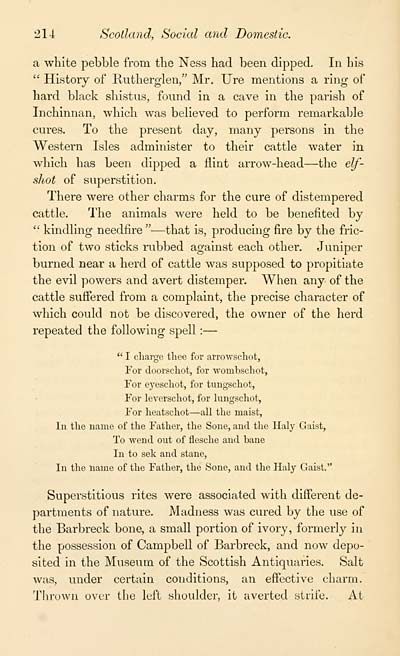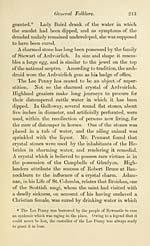Grampian Club > Scotland, social and domestic
(220) Page 214
Download files
Complete book:
Individual page:
Thumbnail gallery: Grid view | List view

214 Scotland, Social and Domestic.
a white pebble from the Ness had been dipped. In his
" History of Rutherglen," Mr. Ure mentions a ring of
hard black shistus, found in a cave in the parish of
Inchinnan, which was believed to perform remarkable
cures. To the present day, many persons in the
Western Isles administer to their cattle water in
which has been dipped a flint arrow-head — the elf-
shot of superstition.
There were other charms for the cure of distempered
cattle. The animals were held to be benefited by
" kindling needflre " — that is, producing fire by the fric-
tion of two sticks rubbed against each other. Juniper
burned near a herd of cattle was supposed to propitiate
the evil powers and avert distemper. When any of the
cattle suffered from a complaint, the precise character of
which could not be discovered, the owner of the herd
repeated the following spell : —
" I charge thee for arrowschot,
For doorschot, for wombschot,
For eyeschot, for tungschot,
For leverschot, for lungschot,
For heatschot — all the maist,
In the name of the Father, the Sone, and the Haly Gaist,
To wend out of flesche and bane
In to sek and stane,
In the name of the Father, the Sone, and the Haly Gaist."
Superstitious rites were associated with different de-
partments of nature. Madness was cured by the use of
the Barbreck bone, a small portion of ivory, formerly in
the possession of Campbell of Barbreck, and now depo-
sited in the Museum of the Scottish Antiquaries. Salt
was, under certain conditions, an effective charm.
Thrown over the left shoulder, it averted strife. At
a white pebble from the Ness had been dipped. In his
" History of Rutherglen," Mr. Ure mentions a ring of
hard black shistus, found in a cave in the parish of
Inchinnan, which was believed to perform remarkable
cures. To the present day, many persons in the
Western Isles administer to their cattle water in
which has been dipped a flint arrow-head — the elf-
shot of superstition.
There were other charms for the cure of distempered
cattle. The animals were held to be benefited by
" kindling needflre " — that is, producing fire by the fric-
tion of two sticks rubbed against each other. Juniper
burned near a herd of cattle was supposed to propitiate
the evil powers and avert distemper. When any of the
cattle suffered from a complaint, the precise character of
which could not be discovered, the owner of the herd
repeated the following spell : —
" I charge thee for arrowschot,
For doorschot, for wombschot,
For eyeschot, for tungschot,
For leverschot, for lungschot,
For heatschot — all the maist,
In the name of the Father, the Sone, and the Haly Gaist,
To wend out of flesche and bane
In to sek and stane,
In the name of the Father, the Sone, and the Haly Gaist."
Superstitious rites were associated with different de-
partments of nature. Madness was cured by the use of
the Barbreck bone, a small portion of ivory, formerly in
the possession of Campbell of Barbreck, and now depo-
sited in the Museum of the Scottish Antiquaries. Salt
was, under certain conditions, an effective charm.
Thrown over the left shoulder, it averted strife. At
Set display mode to: Large image | Transcription
Images and transcriptions on this page, including medium image downloads, may be used under the Creative Commons Attribution 4.0 International Licence unless otherwise stated. ![]()
| Publications by Scottish clubs > Grampian Club > Scotland, social and domestic > (220) Page 214 |
|---|
| Permanent URL | https://digital.nls.uk/81899324 |
|---|
| Description | Note: Numbers 24-41 are relative to but not part of the Club's series. |
|---|---|

